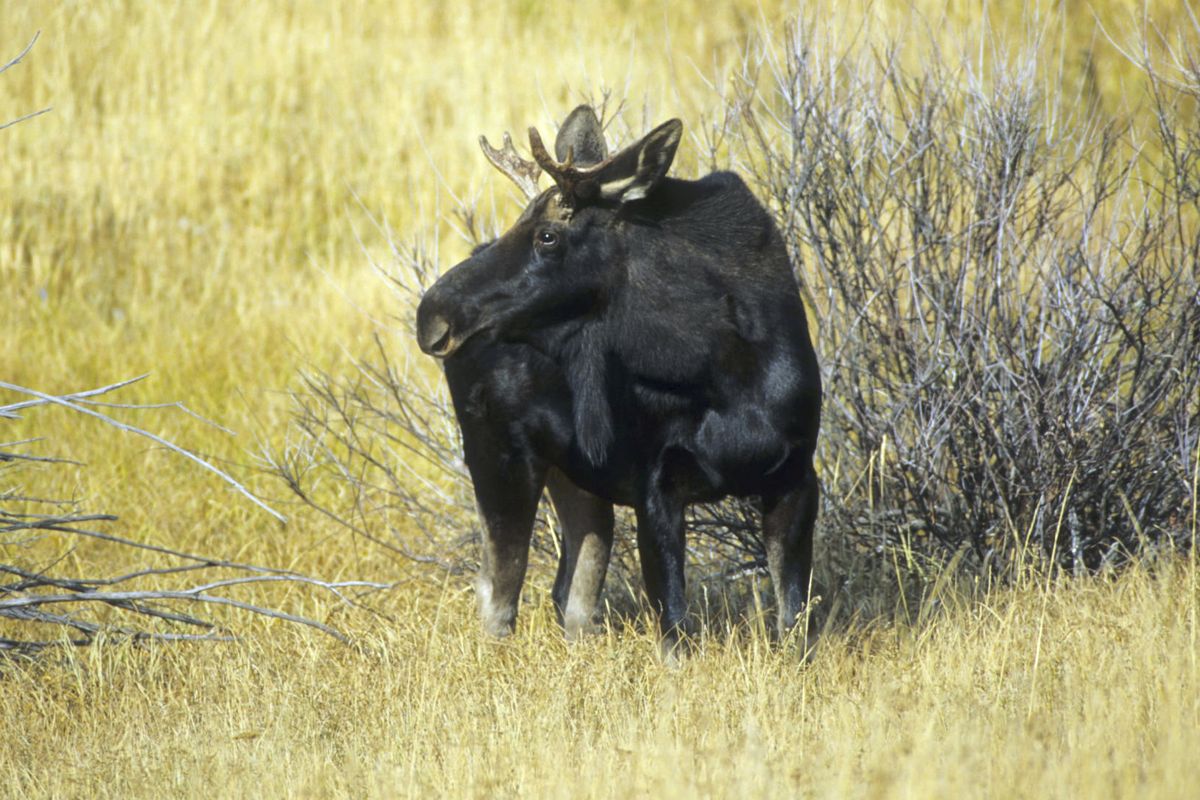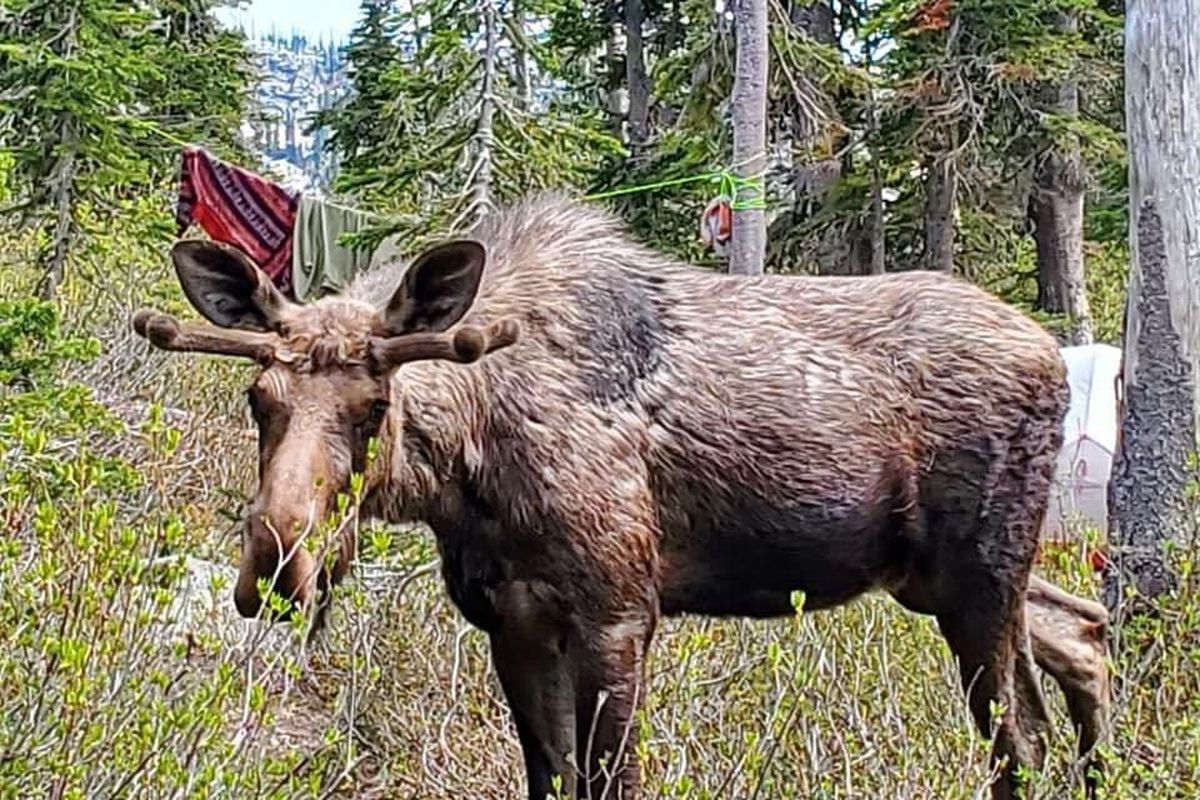Backcountry camper kills moose at Harrison Lake north of Sandpoint, trailhead closed temporarily
(Courtesy of Mike Morrison/IDFG)
Idaho Department of Fish and Game received a report Tuesday of an aggressive bull moose that charged a camper at a Harrison Lake backcountry campsite north of Sandpoint, according to an agency news release.
The moose tore apart the campsite and charged at the camper and his dog. The camper hid behind a tree, but the moose did not stop charging. The camper discharged a firearm at the moose in self-defense from close range, according to the release. Fish and Game responded to the incident and located the deceased moose.
The Forest Service has closed the Harrison Lake trailhead to hikers to prevent possible conflicts between hikers and any bears that may feed on the carcass. The trailhead will be closed for a week.
It’s unclear whether the dog was leashed or not but it was in the man’s camp, IDFG spokeswoman Kara Campbell said. A .45 caliber handgun was used, Campbell said.
“The guy was camping there, so he had a whole camp set up,” she said.
There have been reports of a male moose in the Harrison Lake area for years. Campbell said it’s possible it was the same moose, although IDFG doesn’t know for sure.
Ben Read goes to Harrison Lake anywhere between 15 and 30 times a year and said he’s seen a male moose in the area regularly for the past five years.
“I can’t say there’s never been an issue, because I know people generally run into him around the camp and obviously the two don’t mix,” Read said in a message. “However, I’ve never heard of a charging/trampling issue that someone was never able to avoid or get away from (not to mention probably half of the hikers up there these days carry firearms).”
Last year, the Forest Service posted a note at the trailhead warning about an “aggressive moose” at camp, Read said. Locals familiar with the area warned other hikers and tried to educate them.
But the Harrison Lake trailhead has exploded in popularity in recent years, he said.
“Not that I have any hatred toward Washington residents, as I grew up there, but the trailhead is usually 90% out-of-state plates these days,” Read said. “A few years ago when I was putting up (climbing) routes a lot, I started talking to people on trail and roundabout asking them how they heard about the lake. I’d say it was probably 40% Alltrails (travel mobile app), 40% social media, 10% friend recommended and 10% revisiting.”
That ease of access has led to an increase in poorly prepared and educated hikers and campers, he said.
“Now there are crowds visiting it that would normally have no business being in that kind of environment,” he said. “And by that, I mean people that attempt it in sandals without water or people that generally never respect their surroundings or other people around them.”
Read said he has seen pit bulls running wild, broken glass along the lakeshore and people defecating within 10 feet of the lake.
“I’ll be the first to preach that I think everyone needs a little mountain in their life, but some people obviously just don’t have the integrity to be up there,” Read said.
“I’ve spent enough time to up there to be witnessing its downfall firsthand and I’d really love to be able to take my future kids up there one day without buying a permit or having to fight through crowds to get a view of the lake.”
Harrison Lake is one of the most popular trailheads in the Idaho Selkirks and the lake itself has some backcountry camping spots. The Forest Service doesn’t track trailhead usage numbers at Harrison Lake. The concentration of people, alongside wildlife like moose, bears and wolves, means campers must educate themselves, Campbell said.
“Educate yourself,” she said. “Bear spray isn’t just for bears.”
It can be used as a highly effective tool against other mammals if an unsafe wildlife encounter occurs. Be prepared when recreating outdoors and know how to use bear spray if necessary.
Always give moose a wide berth when you encounter them. Moose, like any wildlife, can become agitated if they feel you are a threat.
Recreationists are reminded to never allow dogs to chase moose. Dogs can be viewed as a threat, especially if they chase a moose. The safest approach is to keep dogs on leash when recreating in moose country.
When hiking, make noise to announce your presence so you do not surprise a moose, or any wildlife that can be dangerous.
Do not hike or trail run with headphones or ear buds. Most wildlife will give out some kind of warning sounds prior to an attack or aggression. Wearing headphones or ear buds eliminates your extremely valuable sense of hearing.
If you encounter a moose, watch its behavior and look for signs of agitation or stress. If a moose lays its ears back or the hair on its neck raises, that means it is stressed and could charge.
If you see any of these behaviors, the best course of action is to put something between you and the moose as a barrier – like a tree or a vehicle.
There are times when a moose might be more apt to charge a person or dog:
- Never put yourself between a cow and calf moose
- During the mating rut in the fall, males can become agitated.
- In late winter, when moose are coming out of a long winter, food is scarce and their fat reserves are depleted. This is a stressful time for moose, as well as other wildlife.
For more information about the trail opening back up to hikers, contact the Sandpoint Ranger District office at (208) 263-5111.

